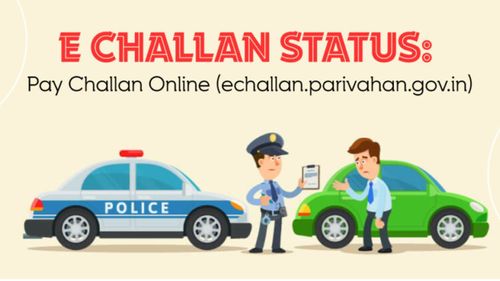eChallan Guide | How to check status and Pay Fines
By Mohit Kumar

3524 Views
How to check status of eChallan and pay fines. Step by Step guide and information you need to know.

Have you ever felt the frustration of getting caught up in a traffic violation mess? We've all been there, right? But guess what, the game is changing, and it's changing fast! Let's talk about E-challans – the digital superheroes that are giving traditional traffic tickets a run for their money.
Imagine getting a "Hey, you goofed up" message on your phone, paying up with a couple of clicks, and moving on with your day. No more long waits or paperwork nightmares. Curious? Buckle up as we dive into the world of E-challans, spilling the beans on how they roll, why they rock, and how you can be a champ at this modern traffic game. Your road to hassle-free fines starts here
In the fast-paced world of today, where technology continues to reshape our daily lives, it's no surprise that even traditional practices such as traffic enforcement have undergone a digital transformation.
Also Read: Indian Road Safety Laws
The Evolution of Challans:
Gone are the days when traffic offenders had to endure long wait times to receive a physical challan for their violations. E-challans, or electronic challans, have revolutionized the process, making it more streamlined and hassle-free.
These digital documents are generated and issued electronically to offenders, eliminating the need for manual paperwork and reducing the chances of errors.
The Functionality of E-Challans:
E-challans are generated through a sophisticated network of surveillance cameras, electronic monitoring systems, and law enforcement databases.
When a traffic violation occurs, such as speeding, running a red light, or improper parking, the system captures relevant details like the vehicle's registration number, location, and timestamp. This data is then used to issue an E-challan to the vehicle owner's registered mobile number or email address.
Also Read: Top 10 Family Cars under 25 lakhs
How E-Challans Work: A Step-by-Step Guide

E-challans have transformed the way traffic violations are managed, making the process quicker, more efficient, and user-friendly. Here's a step-by-step guide on how E-challans work and what individuals need to do in case they receive one:
Step 1: Detection of Violation:
The process begins with the detection of a traffic violation through various surveillance systems, including cameras, sensors, and automated monitoring devices. Common violations include speeding, running red lights, and improper parking.
Step 2: Data Collection:
Once a violation is detected, the system collects relevant data such as the vehicle's registration number, location, timestamp, and images or videos of the violation. This information is crucial for accurately issuing the E-challan.
Step 3: E-Challan Generation:
Using the collected data, an E-challan is generated electronically. The E-challan includes details of the violation, the fine amount, and instructions on how to proceed with payment.
Step 4: Notification to Offender:
The offender is then notified about the E-challan through SMS, email, or a dedicated mobile app. The notification includes a link to the payment portal and information on how to access the E-challan details.
Step 5: Accessing E-Challan Details:
Upon receiving the notification, the offender can click on the provided link to access the E-challan details. This may include images or videos of the violation as evidence.
Step 6: Payment Options:
The E-challan notification provides multiple payment options. Offenders can choose from methods such as credit/debit cards, mobile wallets, net banking, or other available digital payment options.
Step 7: Payment and Confirmation:
Once the payment is made, a confirmation of the transaction is provided. An electronic receipt is generated, serving as proof of payment for the fine.
Step 8: Checking Payment Status:
In case an offender wishes to verify the payment status or review the details of the violation and payment, they can access the dedicated online portal or mobile app provided by the traffic enforcement authorities.
Step 9: Appeal and Grievance Redressal (Optional):
If an offender believes that the E-challan was issued in error, most E-challan systems offer an option to appeal the decision. This involves providing additional information or evidence to contest the violation.
Step 10: Compliance and Record Keeping:
Once the fine is paid, the offender is considered to have complied with the penalty. The traffic enforcement authorities maintain electronic records of the violation, payment, and related information for future reference.
Also Read: Kia Seltos Top Model Price
How to Check E-Challan Status
As of my last update in September 2021, to check E-Challan status in Haryana, you could have followed these steps:
Method 1: Using the Parivahan Sewa Website:
-
Open your web browser and visit the official Parivahan Sewa website: https://parivahan.gov.in/.
-
Look for the "Online Services" or "E-Challan" section on the website's homepage.
-
Click on the "Check Challan Status" or similar option.
-
Select your state.
-
You will need to enter either your vehicle's registration number or the Challan number.
-
After entering the required details, click on the "Get Details" or "Check Status" button.
-
The website should then display the status of your E-Challan, including whether it's pending, paid, or any other relevant information.
Method 2: Using the mParivahan Mobile App:
-
Download and install the "mParivahan" app from the Google Play Store (for Android devices) or the Apple App Store (for iOS devices).
-
Open the app after installation.
-
Tap on the "Challan" option or a similar option that allows you to check E-Challan status.
-
Choose your state as Haryana.
-
Enter either your vehicle's registration number or the Challan number.
-
Tap on the "Get Details" or "Check Status" button.
-
The app should then display the status of your E-Challan.
Also Read: Driving an Electric Car in Summer: Tips and Precautions
Benefits of E-Challans:
Convenience:
E-challans spare individuals from the hassle of physically visiting a traffic police station or court to pay fines. Offenders can pay their fines online, saving time and effort.
Swift Process:
The entire process, from the violation occurrence to issuing the E-challan, takes only a few minutes. This rapid response promotes immediate accountability.
Reduced Corruption:
E-challans minimize human intervention, reducing the possibility of bribery or corrupt practices during the issuance of fines.
Environmentally Friendly:
By eliminating paper-based documentation, E-challans contribute to environmental conservation by reducing paper consumption.
Accurate Data:
Automation ensures accurate capturing of violation details, minimizing errors that might occur due to manual data entry.
Traffic Management:
The efficient handling of traffic violations contributes to better traffic management, which in turn leads to safer roads and reduced congestion.w
The Payment Process:
Paying E-challans is a straightforward process. Once an E-challan is issued, the offender receives a notification containing a link to the payment portal.
Payments can be made through various methods, such as credit/debit cards, mobile wallets, or net banking.
After the payment is processed, an electronic receipt is generated, providing proof of payment.
Ensuring Data Security:
As with any digital system, ensuring the security of personal and sensitive information is crucial. E-challan systems implement encryption and stringent security measures to safeguard user data and prevent unauthorized access.
Challenges and Future Prospects:
While E-challans offer numerous advantages, challenges such as connectivity issues, technical glitches, and the digital divide need to be addressed to ensure widespread adoption, particularly in regions with limited internet access.
However, as technology continues to evolve, these obstacles are likely to be overcome, making E-challans an integral part of modern traffic enforcement.
Also read: How to claim Insurance for your Car after Flood
Conclusion
E-challans exemplify the harmonious blend of technology and governance, providing a user-friendly solution to manage traffic violations. By simplifying the process of issuing and paying fines, E-challans contribute to more efficient traffic management, reduced corruption, and overall road safety.
As our world becomes increasingly digitized, embracing innovations like E-challans is a step towards building smarter, safer, and well-organized urban landscapes.